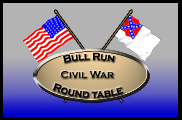 Bull
Run Civil War Round Table
Bull
Run Civil War Round Table  Bull
Run Civil War Round Table
Bull
Run Civil War Round Table
Confederate blockade of the Potomac
1861-2:
Gunnery Effectiveness — not good
| For the most part, the same could be
said of the Confederate batteries. With all the guns
they possessed, one would think any ship within range
would have been blown right out of the water. We
should have a long list of ships sunk; we don’t. Occasionally a ship was hit but rarely was the damage serious. The Harriet Lane was struck on the port wheelhouse but such incidents were rare when you consider that the ships of the Flotilla passed the batteries day and night. Light-draft vessels generally passed under fire but safely at night. Regulars on the Potomac were the oyster boats and only one is recorded as being hit but not sunk. General Hooker commented that from his observations, “they are as likely to be struck by lighting as by rebel shot.” … It is thought that there were thirty-seven heavy guns and an unknown number of lighter ones on the Virginia shore. Hooker had little respect for them. “They do fire wretchedly,” he said. “Whether it is owing to the projectiles or the guns I am not informed. From what was witnessed today and on previous occasions, I am forced to the conclusion that the rebel batteries in this vicinity should not be a terror to anyone. With a light breeze or a favorable current, a seventy-four line of battleships could ascend or descend the river at night with impunity.” Over 5000 shots were fired by the Confederate gunners during the blockade and few found their mark. The contempt in which the rebel gunners were held was exemplified by the captain of the Mystic, a commercial steamer, which ran the batteries in mid-January. When the vessel was directly in front of Shipping Point, which had the heaviest concentration of guns, the engine was deliberately stopped and the gunners challenged to hit the boat. Altogether eighty-seven shots were fired at it and after each shot, all of which missed, the crew jeered and laughed at the inept artillerists. … One might think, however, that they would learn from almost daily experience and become accurate. Such was not the case. It was a fact that ships choosing to run the batteries usually made it. Officially, however, the river was closed to larger ships and those carrying Government supplies by order of the U.S, Navy. Perhaps most of those would have made it to Washington too, if they had tried. The Confederate Blockade of Washington, D.C. 1861-1862, Mary Alice Wills, McClain Printing Company, Parsons, WV 1975 p108-112 (available from Prince William County Historical Site gift shops) The blockade wasn’t completely feckless Captain Thomas T. Craven, U.S. Navy Commanding Potomac Flotilla, Steamer Harriet Lane USS SEMINOLE Hampton Roads, October 16, 1861 DEAR CRAVEN: Did you hear the row? We had quite a sharp action with the rebel batteries, three in number as we passed Evansport yesterday. It continued about forty minutes, as the “old wagon” moved leisurely down the river. Two of the forts are on the bank of the river, the other lies inland 300 or 400 yards. They poured the rifled shot and shell into us in a lively manner, which we answered briskly so long as our guns could be brought to bear. We kept steadily on our course, deeming it a matter of more importance to take the vessel uninjured to her destination for work of more consequence than shelling the batteries of the Potomac. The Pocahontas stirred up the party with a gun or two as she steamed down ahead of us, which the batteries did not reply to. She continued on, leaving us to do battle with the Dixie boys. They did us some damage. The “varmints” shot away our mizzenmast and mizzen after shroud, also both mainstays near masthead, sent two shot through our rail and hammock nettings, and doing us some injury inboard, as they passed through both sides. A shell or two burst under our starboard bow, giving us a fine shower bath at pivot gun, and burying some fragment in outside planking, etc. Sincerely yours, JNO. P. GILLIS …. While the Mount Vernon was able to pass safely downstream at night, both the USS Pawnee and Seminole were struck several times by the batteries in broad daylight. More troubling was the risk posed for slower moving commercial vessels, which would be sailing upstream against the current, laden with goods for Washington, D.C. STRATAGEM 1861: Early Civil War Tactics and the Battle for the Potomac, Robert H.C. Alton p.46 |
Contact: Alan Day webmaster@bullruncwrt.org